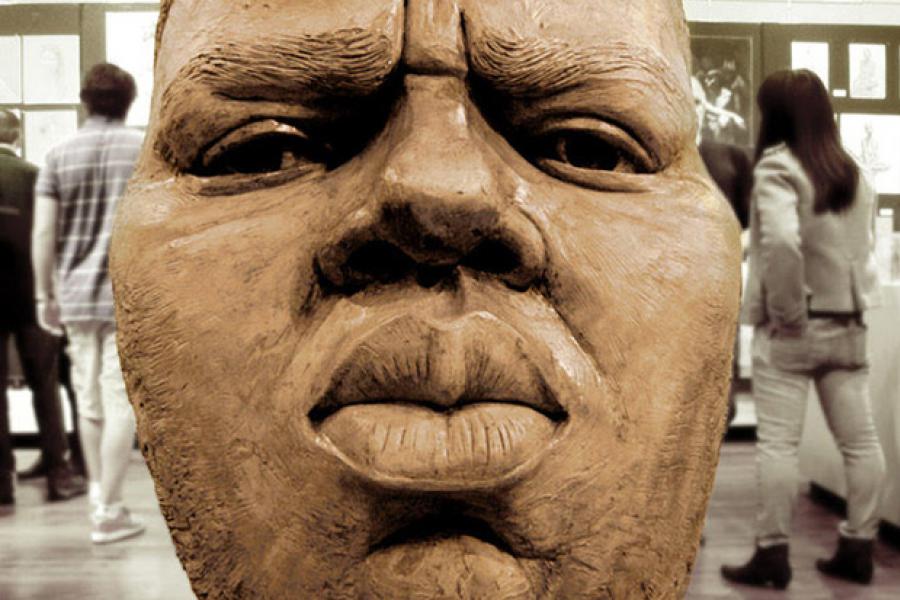Biggie Smalls

Musical style:
Wallace mostly rapped on his songs in a deep tone described by Rolling Stone as a "thick, jaunty grumble", which went deeper on Life After Death.He was often accompanied on songs with ad libs from Sean "Puffy" Combs. On The Source's Unsigned Hype, his style was described as "cool, nasal, and filtered, to bless his own material".
Allmusic describe Wallace as having "a talent for piling multiple rhymes on top of one another in quick succession".Time magazine wrote Wallace rapped with an ability to "make multi-syllabic rhymes sound... smooth",while Krims describes Wallace's rhythmic style as "effusive."Before starting a verse, Wallace sometimes used onomatopoeic vocables to "warm up" (for example "uhhh" at the beginning of "Hypnotize" and "Big Poppa" and "whaat" after certain rhymes in songs such as "My Downfall").
Lateef of Latyrx notes that Wallace had, "intense and complex flows",Fredro Starr of Onyx says, "Biggie was a master of the flow"and Bishop Lamont states that Wallace mastered "all the hemispheres of the music". "Notorious B.I.G. also often used the single-line rhyme scheme to add variety and interest to his flow". Big Daddy Kane suggests that Wallace didn't need a large vocabulary to impress listeners – "he just put his words together a slick way and it worked real good for him". Wallace was known to compose lyrics in his head, rather than write them down on paper, in a similar way to Jay-Z.
Wallace's lyrical topics and themes included mafioso tales ("Niggas Bleed"), his drug dealing past ("10 Crack Commandments"), materialistic bragging ("Hypnotize"), as well as humor ("Just Playing (Dreams)") and romance ("Me & My Bitch") Rolling Stone named Wallace in 2004 as "one of the few young male songwriters in any pop style writing credible love songs".
Guerilla Black, in the book How to Rap, describes how Wallace was able to both "glorify the upper echelon" and "[make] you feel his struggle". According to Touré of The New York Times in 1994, Wallace's lyrics "[mixed] autobiographical details about crime and violence with emotional honesty".Marriott of The New York Times (in 1997) believed his lyrics were not strictly autobiographical and wrote he "had a knack for exaggeration that increased sales". Wallace described his debut as "a big pie, with each slice indicating a different point in my life involving bitches and niggaz... from the beginning to the end".
Ready to Die is described by Rolling Stone as a contrast of "bleak" street visions and being "full of high-spirited fun, bringing the pleasure principle back to hip-hop"Allmusic write of "a sense of doom" in some of his songs and the NY Times note some being "laced with paranoia";Wallace described himself as feeling "broke and depressed" when he made his debut.[87] The final song on the album, "Suicidal Thoughts", featured Wallace contemplating suicide and concluded with him committing the act.
On Life After Death, Wallace's lyrics went "deeper" Krims explains how upbeat, dance-oriented tracks (which featured less heavily on his debut) alternate with "reality rap" songs on the record and suggests that he was "going pimp" through some of the lyrical topics of the former.XXL magazine wrote that Wallace "revamped his image" through the portrayal of himself between the albums, going from "midlevel hustler" on his debut to "drug lord".
Allmusic wrote that the success of Ready to Die is "mostly due to Wallace's skill as a storyteller"; in 1994, Rolling Stone described Wallace's ability in this technique as painting "a sonic picture so vibrant that you're transported right to the scene". On Life After Death Wallace notably demonstrated this skill on "I Got a Story to Tell", creating a story as a rap for the first half of the song and then retelling the same story "for his boys" in conversation form.